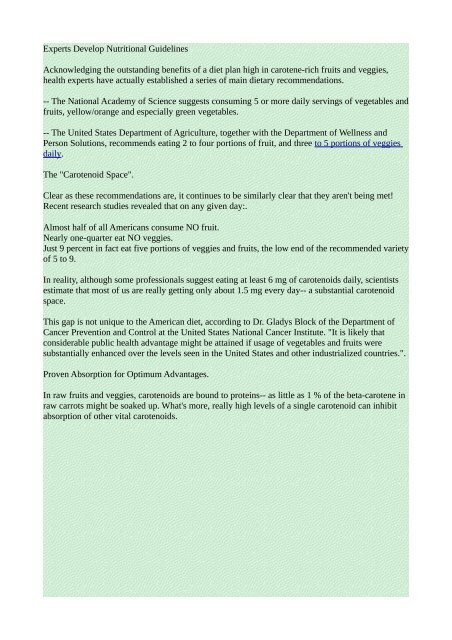The Carotenoid Gap: Carotenoid Health Perks Discovered
Often called "nature's crayons", carotenoids are a huge household of colorful plant pigments, numerous of which serve as precursors of Vitamin A. Carotenoids are liable for the red in tomatoes, the orange in carrots, and the yellow in squash. They are also present in green plants such as spinach, where they are obscured, or masked, by green chlorophyll.
Often called "nature's crayons", carotenoids are a huge household of colorful plant pigments, numerous of which serve as precursors of Vitamin A. Carotenoids are liable for the red in tomatoes, the orange in carrots, and the yellow in squash. They are also present in green plants such as spinach, where they are obscured, or masked, by green chlorophyll.
Create successful ePaper yourself
Turn your PDF publications into a flip-book with our unique Google optimized e-Paper software.
Experts Develop Nutritional Guidelines<br />
Acknowledging the outstanding benefits of a diet plan high in carotene-rich fruits and veggies,<br />
health experts have actually established a series of main dietary recommendations.<br />
-- <strong>The</strong> National Academy of Science suggests consuming 5 or more daily servings of vegetables and<br />
fruits, yellow/orange and especially green vegetables.<br />
-- <strong>The</strong> United States Department of Agriculture, together with the Department of Wellness and<br />
Person Solutions, recommends eating 2 to four portions of fruit, and three to 5 portions of veggies<br />
daily.<br />
<strong>The</strong> "<strong>Carotenoid</strong> Space".<br />
Clear as these recommendations are, it continues to be similarly clear that they aren't being met!<br />
Recent research studies revealed that on any given day:.<br />
Almost half of all Americans consume NO fruit.<br />
Nearly one-quarter eat NO veggies.<br />
Just 9 percent in fact eat five portions of veggies and fruits, the low end of the recommended variety<br />
of 5 to 9.<br />
In reality, although some professionals suggest eating at least 6 mg of carotenoids daily, scientists<br />
estimate that most of us are really getting only about 1.5 mg every day-- a substantial carotenoid<br />
space.<br />
This gap is not unique to the American diet, according to Dr. Gladys Block of the Department of<br />
Cancer Prevention and Control at the United States National Cancer Institute. "It is likely that<br />
considerable public health advantage might be attained if usage of vegetables and fruits were<br />
substantially enhanced over the levels seen in the United States and other industrialized countries.".<br />
Proven Absorption for Optimum Advantages.<br />
In raw fruits and veggies, carotenoids are bound to proteins-- as little as 1 % of the beta-carotene in<br />
raw carrots might be soaked up. What's more, really high levels of a single carotenoid can inhibit<br />
absorption of other vital carotenoids.


















